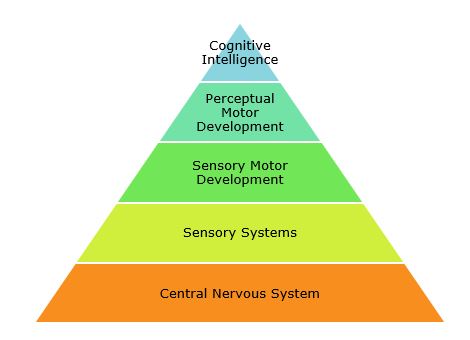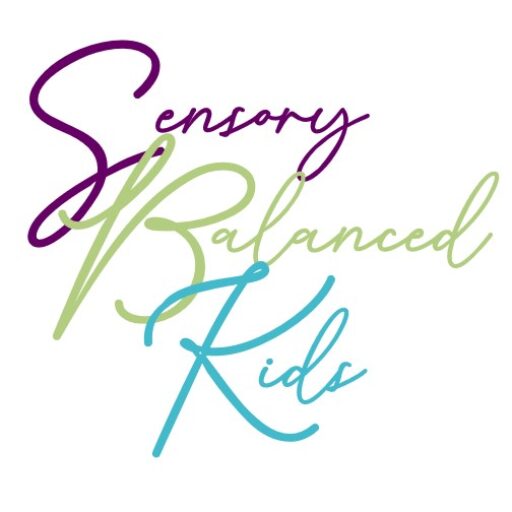
The Pyramid of Learning
What is the Pyramid of Learning and why is it important?
The Pyramid of Learning was developed by occupational therapist Kathleen Taylor and special educator Maryann Trott in 1991. It is a conceptual framework used to understand how sensory processing impacts a child’s ability to perform complex tasks and engage in higher-level learning.
The Key is that each level of the pyramid depends on the successful development and integration of the levels below it. For example, poor tactile processing can impact fine motor skills, which in turn can affect writing abilities. This means that if you experience that your kiddo has problems with his handwriting, giving him lots and lots of exercises in handwriting might not have any significant effect unless you also work on his tactile processing.
By addressing issues at the foundational levels, you can help your child build the necessary skills for successful learning and daily living. Let’s take a look at the levels:

Levels of the Pyramid of Learning from the base to the top:
Central nervous system: At the base is the central nervous system. In short this is where we receive information from the nervous system, transmits it to the brain for processing and produce a motor output for the body. Primitive reflexes are automatic movements that originate in the brainstem and are present at birth. Proper integration of these reflexes is essential for the maturation of the central nervous system.
Sensory systems: The 7 senses is how we receive the information in the central nervous system. Through olfactory (smell), visual, auditory, gustatory (taste), tactile, vestibular and proprioception. Sensory processing disorders occur when the brain has trouble receiving and responding to information that comes in through the senses.
Sensory Motor Development: Basic motor skills and body control, such as moving our eyes, feeling stable, and the ability to think about and execute movements (e.g. learning a new dance step or moving to the left so that we don’t knock into the table)
Perceptual Motor Development: Here lies the ability to interpret sensory information and coordinate it with movements, like understanding what we see and hear and using that information to move accurately (e.g. hand-eye coordination)
Cognitive Intelligence: At the top lies the abilities to e.g. maintain concentration, Problem-solving skills, Academic learning and Social skills.
The understanding of the Pyramid of Learning is very important when assessing the difficulties you experience with your kiddo. If something is underdeveloped at the first 2 levels, your child will use so much effort doing tasks that others do almost automatic. And this leaves exhausted and frustrated kids, with very little energy to accomplish new skills.
Let me give you some examples.
Examples on the problem you see and the possible underlying problem
Example 1: Frequent Tantrums and Emotional Outbursts
The child becomes easily frustrated, cries often, and has difficulty calming down.
Possible Sensory Processing Issue: Over-responsiveness to sensory stimuli, leading to sensory overload and emotional dysregulation.
Possible Retained Primitive Reflex: Retained Moro Reflex. This can cause an exaggerated stress response, making it harder for the child to cope with sensory input and leading to frequent emotional outbursts.
Example 2: Poor Coordination and Clumsiness
The child frequently bumps into things, has trouble with sports, and struggles with activities that require coordination.
Possible Sensory Processing Issue: Vestibular and proprioceptive processing difficulties, affecting balance and body awareness.
Possible Retained Primitive Reflex: Retained Symmetrical Tonic Neck Reflex (STNR). This reflex can interfere with the development of coordinated movements and balance, contributing to clumsiness.
Example 3: Challenges with Reading
The child has trouble tracking words on a page and often skips lines
Possible Sensory Processing Issue: Visual processing difficulties, affecting the ability to coordinate eye movements and focus on text.
Possible Retained Primitive Reflex: Retained Asymmetrical Tonic Neck Reflex (ATNR). This reflex can cause difficulties with coordinating both sides of the body and with tracking across midline, which is essential for reading and writing.
Example 4: Overreaction to Loud Noises
The child covers their ears, becomes anxious, or cries when exposed to loud sounds like fire alarms or crowded places.
Possible Sensory Processing Issue: Auditory hypersensitivity, where the child’s brain overreacts to auditory stimuli.
Possible Retained Primitive Reflex: Retained Moro Reflex. This reflex can cause an exaggerated startle response to sudden noises, leading to heightened anxiety and sensory defensiveness.
As you can see with the above examples, it all comes down to integration of the primitive reflexes and sensory processing abilities.

Get in Touch
I am happy to receive questions and comments!
